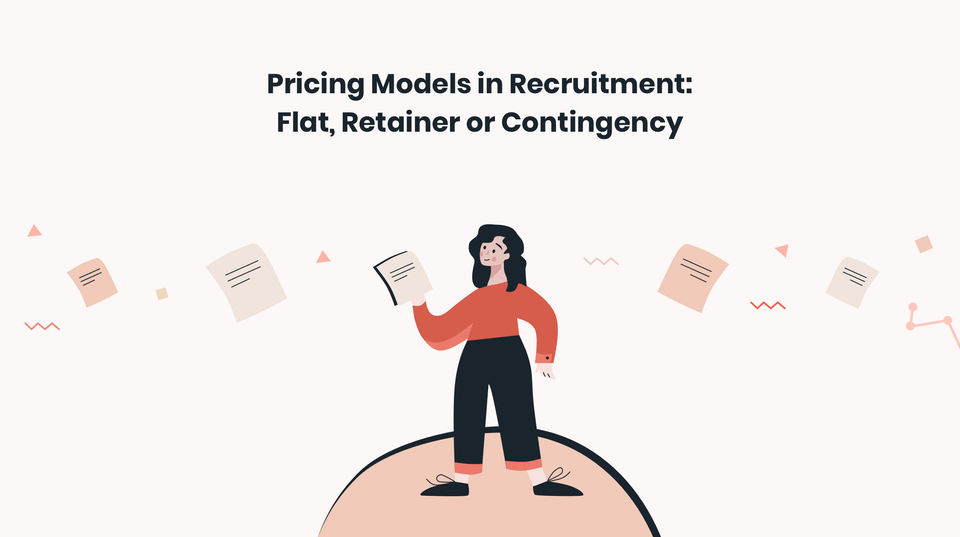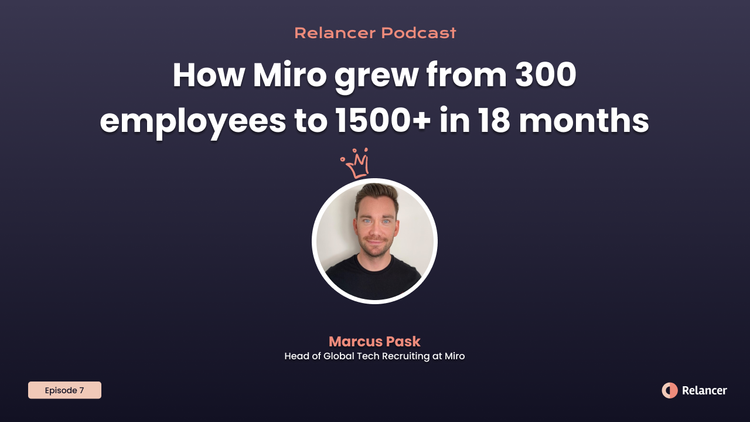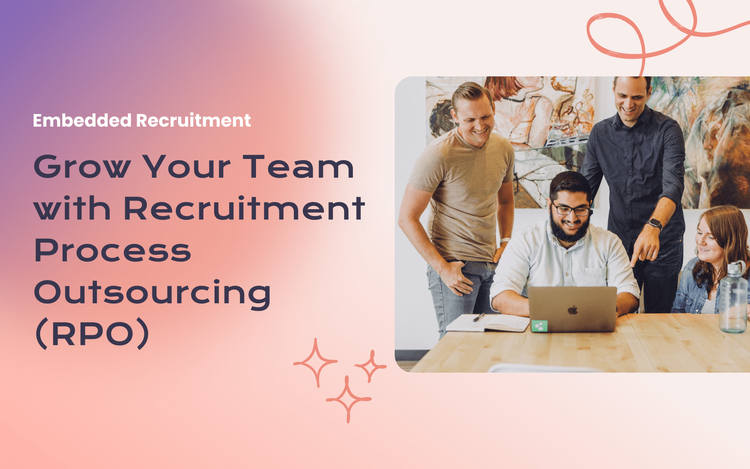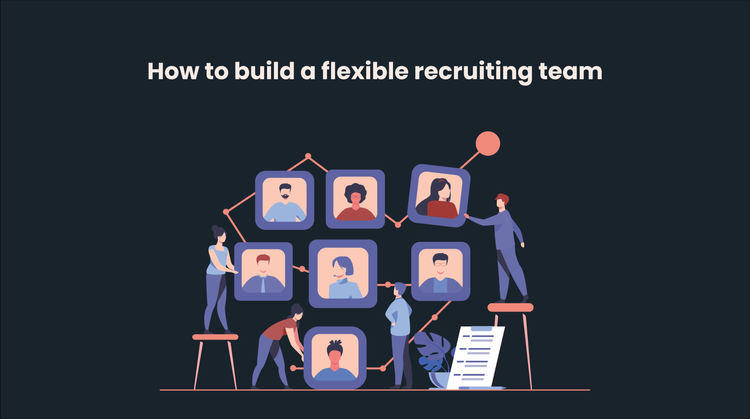Pricing Models in Recruitment: Flat, Retainer or Contingency

When we introduce Relancer's collaboration options to our potential clients, they are often surprised that there are more pricing models than the oh-so-popular contingency model (e.g. success fee).
A fact that's even more surprising – the pricing model determines the overall collaboration type between your recruiting partner. Your success can highly depend on choosing the right model.
Why? Because pricing sets the expectations and commitment for both sides. Think of it this way, pricing model = collaboration type = level of commitment. Sometimes it makes sense to have less commitment from your recruiting partner, other times you want someone who is highly vested or even integrated into your team.
If this sounds confusing at first, keep reading. 😉 After the next 8 minutes, you'll know the pros and cons of these three main models:
- Contingency model – pay for results (percentage or fixed fee)
- Flat model – pay for time (hourly or daily rate)
- Retainer model – pay for milestones (percentage combined with fixed fee)
Sounds useful? Let's get started!
Contingency model: pay for results
The pay-for-results aka contingency fee is the most common collaboration model with external recruiters and recruitment agencies. Companies prefer it due to lowered risk and recruiters like the potential of receiving higher earnings.
In general, a contingency fee is calculated as a percentage of the annual salary of the placed candidate. According to Undercover Recruiter, the majority of recruiting fees run between 15% and 25% of the candidate’s total first-year annual earnings. However, the recruitment fee can go up to 50% for hard to fill or senior positions.
Some recruiters want to keep things simple with a fixed contingency fee based on the salary range of the candidate. For example, if a candidate is paid between $70,001 and $80,000 the flat fee may be $9,000.
Level of commitment: low to medium
Contingency recruiters work with multiple clients at the same time and prefer projects where they can get results faster and with less effort. It can lead to a lot of confusion, as the client doesn't know how committed the recruiter is. Having open and transparent communication is crucial. Be honest and upfront about your situation and expectations, and emphasize the recruiter to do so as well.
Best suited for:
- When you're already doing some recruiting on your own (or in-house) but want to have an additional source for candidates.
- When you've already used up most of your recruitment budget.
- When you're working with multiple agencies at the same time.
- When you're in a hurry and want to get as many candidates from as many sources as possible.
- When you prefer quantity over quality.
Real-life examples of fees:
- Boutique recruitment agency – Software engineering role – London – 25% (approx. £15 000) contingency fee
- Boutique recruitment agency – Software engineering role– Tallinn – 15% (approx. €7 000) contingency fee
- Recruitment agency – Marketing manager – Buenos Aires – 20% (approx. $5000) contingency fee
- Freelance tech recruiter – Tallinn – 4500€ fixed contingency fee
🚨Disclaimer 🚨
These are just a few examples. The prices depend on your location, the role you're looking to fill and/or the specific task. Let's discuss your specific situation - claim your free consultation.
Pro tip: Avoid working with too many contingency recruiters at the same time.
By doing so, you're fostering the spray-and-pray mentality. Meaning: agencies are competing for your placement fee and often get sloppy with the quality. You will become frustrated with the agency and thus, start working with more and more recruiting partners. It's a poor cycle to be in.
It can also create a poor employer image and experience for your candidates. Recruiters are competing against other recruiters to “catch” and submit the same candidate profiles. Unwanted behaviours can include spamming, overpromising, giving out confusing information and sending you candidates who are not truly suited for your position.
Taking a step back, the contingency pricing model in itself is not a bad option if you have a mutual understanding of commitment. But you want to avoid collecting pay-for-results get-no-results recruiting partners and start setting better collaboration terms. Make sure you are working towards success not just hoping to get lucky.
Flat model: hourly or daily rate
Although all recruiters have preferences regarding their pricing models, most of them are flexible and open to a discussion. Especially freelance recruiters and small boutique agencies.
It's a common misconception that experienced recruiters only work on a contingency basis because it takes them much less time to deliver results than more junior recruiters. Fortunately, modern forward-thinking recruiters lean towards having a more personal committed relationship with their clients. They understand that pay-per-results models do not support building a strong relationship and being quality-focused.
That's why more than half of the recruiters we work with have already set their daily or hourly rates. 💪You can pick their brilliant brains by the hour.
Level of commitment: high (while still being flexible)
What I mean by flexibility – you're not stuck with having to get a full recruitment service. You can set the project scope, even if you only need some help with doing interviews for a few weeks. It can be 20h or 100h per month. It can consists of only creating a recruitment strategy or doing hands-on sourcing. You'll have a lot more options than with a retainer or contingency model.
Best suited for:
- When you need help with a very specific task (e.g. only sourcing or pre-screening or improving employer branding).
- When you have multiple similar roles to fill or plan to work with the recruiter long(er)-term.
- When you don't have/need an in-house recruiter and have no real recruitment processes set up.
- When the estimated contingency fee seems too high for your budget.
- When you're still figuring out the specifics of the role you're looking for and need a recruiter to support you in every step of the recruiting process.
- When the position you're looking for has a more complicated remuneration package and it's difficult to set a contingency fee (e.g. executives and sales people).
Real-life examples of fees:
- A tech recruiter in the UK has a daily rate of £450
- A sourcer in Estonia has an hourly rate of 30€
- A marketing recruiter in Spain has an hourly rate of 35€
- A marketing recruiter in Argentina has an hourly rate of 20$
🚨Disclaimer 🚨
These are just a few examples. The prices depend on your location, the role you're looking to fill and/or the specific task. Let's discuss your specific situation - claim your free consultation.
Pro tip: Like for any project, set clear milestones and deliverables.
The contingency model has a very clear end goal – get a candidate hired, then get paid. With the flat model, flexibility also brings more vagueness to the table. You have to be more clear about what you expect from the recruiter and how you measure results.
Retainer model: pay for milestones
By definition, a “retainer” is:
- a fee paid in advance to someone, especially an attorney, in order to secure or keep their services when required
Quite accurate for recruitment as well. Retainer model is a set of conditions (or milestones) when the payments are released.
It's up to you and the recruiter to set the conditions for payments. But to give you a common example, retainer usually consist of three payments:
- Prepayment (to get started with the project)
- Shortlist (when candidates are sourced, pre-screened and interviewed)
- Commission (when the candidate is hired)
Level of commitment: high
The recruiter is being hired and paid as an outside extension of your internal team. With this type of collaboration, recruiters are more thorough and thoughtful in the process of finding the right candidate. Their focus is on quality and finding the best match for the position.
Best suited for:
- When you need a full-cycle recruitment service.
- When you don't have/need an in-house recruiter or want extra help with some specific roles.
- When you want to assure quality and get someone working with you more personally than a contingency recruiter.
- When you don't have multiple recruiters (or agencies) working on the same position (you'll give exclusivity to this one recruiter).
Real-life examples of fees:
- Software engineering role – London – 50% in advance, 50% for a successful hire. Total cost of £10 000.
- Software engineering role – 20% in advance, 30% for the shortlist, 50% for a successful hire. Total cost in Estonia 4500€ vs. in Miami Beach $12 000.
- Marketing manager role – Buenos Aires – 20% in advance, 80% for a successful hire. Total cost of $3000.
To compare, the total cost of a retainer is 25–50% lower than contingency, yet the retainer model gets you so much more attention, time and quality from the recruiter. You just have to invest a bit in advance. 😉
🚨Disclaimer 🚨
These are just a few examples. The prices depend on your location, the role you're looking to fill and/or the specific task. Let's discuss your specific situation - claim your free consultation.
Pro tip: For a retainer model, find a recruiter you can trust.
It's easy to say, not so easy to do. That's why so many companies prefer to lower their risk with the contingency (pay only for results) model. But for those, who want the benefits of a retainer model… Here's how to figure out your trusted recruiting partner:
- Testing. If you've worked with multiple recruiters or agencies, you already have a good comparison. Pick your best partner so far and discuss your collaboration model.
- References. Ask companies who are similar to yours – size, industry and culture wise. Look for a recruiter who has previous experience with the roles you need to fill.
- Small and specialized. Boutique agencies and freelancer recruiters tend to be more specialized in a niche (roles or industries), so they know their field better. They're also more forth-coming and personal regarding collaboration.
- Relancer. I'll risk sounding unprofessionally biased (yes, this is us 🙋♀️) but should you search and evaluate recruiters yourself, when someone has already done it for you? We'll get you connected with the best recruiters around. 😉
Key takeaways
I hope you now understand the importance of selecting the right pricing model. Don't be fooled into thinking that working with as many recruiters on a pay-per-result basis is the best recruiting support you can get.
Talk to your recruiting partner, have an open discussion on how to make your collaboration a success. Sometimes the contingency model truly is the best option, other times working per-hour or per-milestone will get you a more personal and quality-driven approach.
It all comes down to one question: do you want an additional maybe-get-lucky stream of candidates or a dedicated recruiting partner who is an extension of your team?
I'll leave you with this thought... If you need help figuring out your options – book a call with Relancer Advisors 👋😊






Member discussion